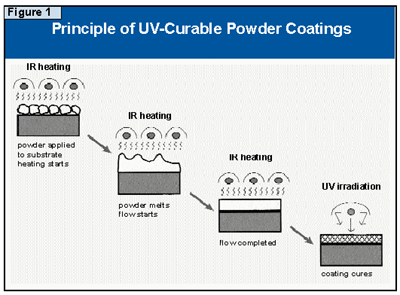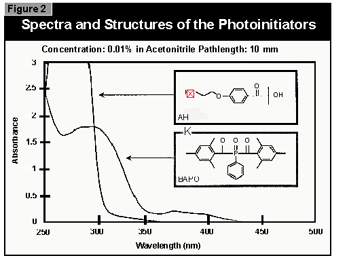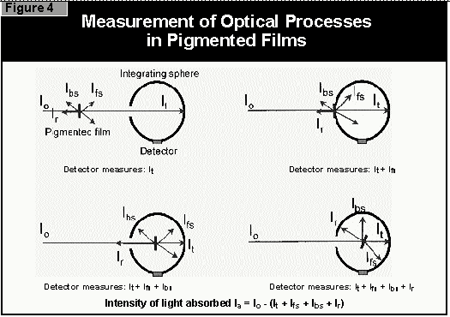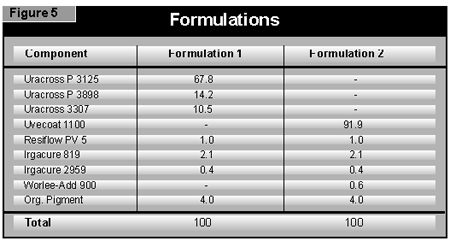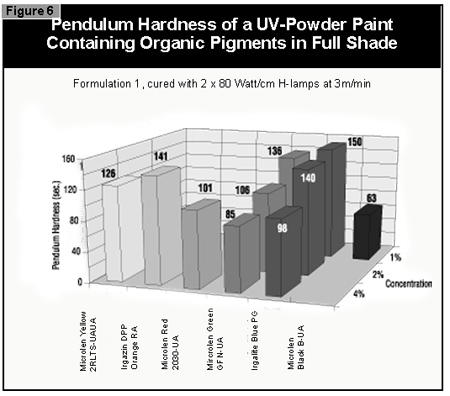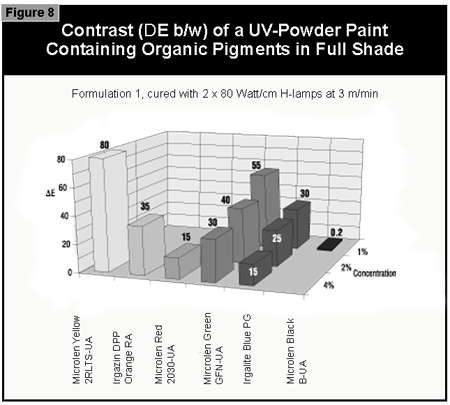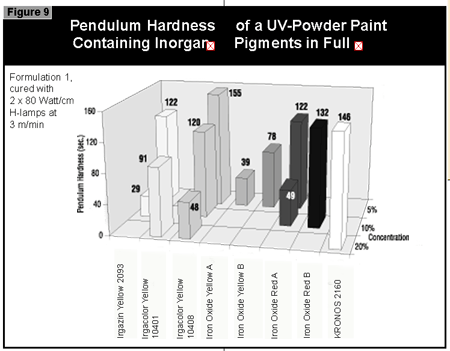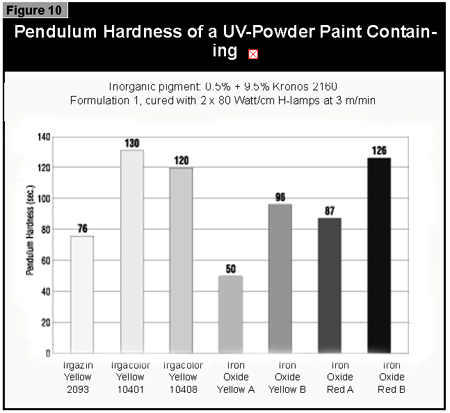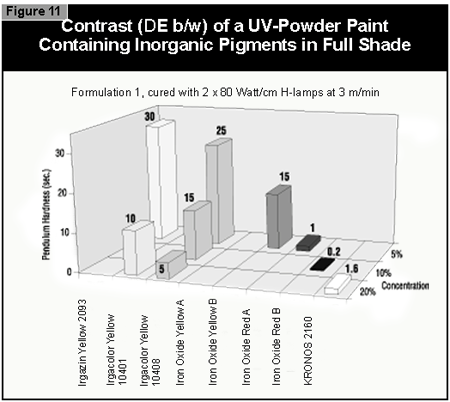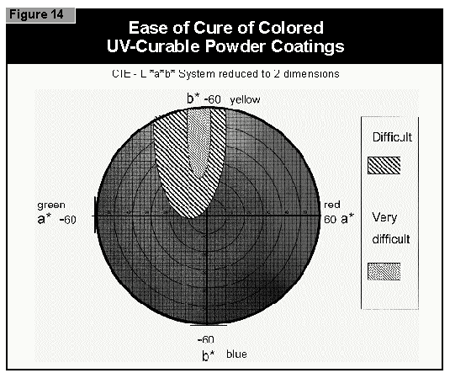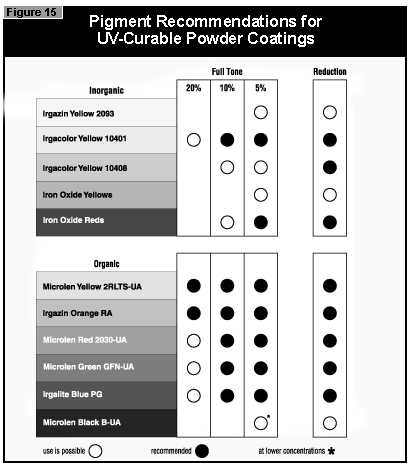www.pcimag.com/articles/93863-pigment-selection-for-colored-uv-curable-powder-coatings
Summer 2000 Vol. 2, No. 2
The
opening of production lines in the United States and Europe has shown that
UV-curable powder coating is now a practical coating technology that can make a
significant contribution towards improving production. The ability to coat
heat-sensitive substrates in a fast, economical and environmentally clean manner
should help bring a rapid expansion of UV-curable powder coatings into
applications traditionally dominated by two-part poly- urethane lacquers.
Problems such as the treatment of wastewater from spray booths and the delay
brought about by the slow cure reaction of polyurethanes are not present in
UV-powder.
In
UV-curable powder coatings, the powder is electrostatically applied to the sub-strate
and then melted at temperatures from 80 to 140°C, just long enough to achieve
the degree of flow required (
Figure 1). The molten coating is then cured
under UV light while hot. In contrast, conventional powder coatings require
temperatures from 180 to 200°C to bring about the cross linking reaction, which
sets in before the surface flow has completely finished.
UV-curable
powder coatings need to be formulated in a variety of surface finishes and
colors, and some initial work on this problem has already been reported
(1).
When selecting pigments for conventional, thermally cured powder coatings, the
thermal stability of the pigment must be considered. This is not a problem with
UV-curable powders. As with conventional powder coatings, however, there is a
need to achieve optimal pigment dispersion in one extruder pass and to have
minimum batch-to-batch variation in color. For these reasons, as well as for
cleaner handling, the use of solid pigment dispersions, such as the Microlen
range of products, is most advantageous.
Selection
of the appropriate photoinitiators is also a matter of great importance. If the
photoinitiator lowers the glass transition temperature of the resin (i.e. has a
plasticizing effect), the storage stability and ability to recycle the
UV-curable powder will be impaired. Other key properties of a suitable
photoinitiator for UV-curable powder coatings are (in addition to the spectral
absorption): low volatility, low yellowness after cure and absence of volatile
scission products that cause odor
(2).
For curing pigmented systems, the combination of an alpha-hydroxyketone (AHK)
and a bis-acylphosphine oxide (BAPO) is the most suitable. The alpha-hydroxyketone
gives the coating good surface cure because this class of compounds is
relatively insensitive to oxygen inhibition. The bis-acylphosphine oxide enables
a deep cure in pigmented systems because it absorbs in the visible at
wavelengths where TiO2 opacifiers are transparent. Also, the ability
of the BAPO class of photoinitiators to photobleach during cure promotes cure
through to the base of the coating.
In
a previous study, bis(2,4,6-trimethylbenzoyl)-phenyl-phosphine oxide (Irga-cure
819) and 1-[4-(2-hydroxyethoxy)-phenyl]-2-hydroxy-2-methyl-1-propan-1-one (Irgacure
2959) were found to fit the requirements for photoinitiators for UV-curable
powder and were therefore used in this work (Figure 2).
For
good curing performance, it is a prerequisite that the absorption spectrum of
the photoinitiator coincides as completely as possible with the emission
spectrum of the lamps. It also follows that the pigments used in the coating
should interfere as little as possible with the absorption of light by the
photoinitiator. When light strikes a pigmented coating, four processes will
occur to a greater or lesser extent (
Figure 3):
- the
light is reflected off the surface of the coating
- the
light is scattered by the pigment
- the
light is absorbed by the pigment
- the
light passes through the coating without being absorbed.
The
relative intensities of the light specular reflection, back and forward
scattering, absorption and transmission through a pigmented film I
r,
I
bs, I
fs, I
a and I
t were measured
using a Perkin Elmer Lambda 900 UV/VIS/NIR spectrophotometer fitted with an
integrating sphere attachment (
Figure 4). A 35- to 40-µm-thick coating
(60-µm wet-film thickness) of an alkyd/melamine paint containing 10% pigment on
a transparent foil was used for the spectral measurements. The spectra were
corrected for the absorbance and reflectance of the substrate. The amount I
t
was determined by measuring the transmission through the film at a
distance of 180 mm from the opening of the integrating sphere. The sum of I
t
+ I
fs was determined with the pig mented
film placed against the opening of the integrating sphere. The reflected
component of the incident light was determined in a similar manner, with the
pigmented film placed inside the integrating sphere at an angle to the incident
light. From the latter measurement, the total light absorbance of the pigment
can be calculated.
The
organic pigments used in this study were tested at 4, 2 and 1% concentrations.
If inadequate cure was obtained at 4%, the results at 2% were chosen; otherwise,
the results were at 1%. Similarly, the inorganic pigments were tested at 20, 10
and 5% concentrations. Where possible, Microlen organic pigment dispersions were
used, as this guaranteed the best possible dispersion quality. Two different
resin systems were used in this work: the Uracross resin system from DSM Resins
was used for coatings onto phosphated steel and the Uvecoat system from UCB
Chemicals for coatings onto medium-density fiberboard (MDF) (
Figure 5).
Whereas the former system produced high-gloss coatings, the latter resulted in
coatings with a unique surface structure. The formulations were extruded once
using only a Prism 16-mm twin-screw at 70 and 80°C, respectively.
The
extrudates were milled to give a powder of mean size at about 45 µm using a
Retsch ultracentrifugal mill and sieved through a 125-µm sieve, and 0.25% of
silica (Aerosil R972) was added to the crushed extrudate before milling to
prevent the finished powders from caking. The powders were sprayed using a
Wagner Tribo-star gun. A coating film of exactly 70 µm was achieved by spraying
the powder first onto a metal panel with a metal backing plate behind it to
prevent powder from adhering to the rear of the panel. In this way, the weight
of powder needed to produce a 70-µm film on the metal panel could be
determined. The MDF panels could then be sprayed in the same manner until the
required weight of powder had been applied.
The
coated panels were then melted under an IR lamp until a surface temperature of
140°C was reached and then cured immediately. The panels were cured in an Aetek
exposure unit by placing them on a moving belt at different speeds and passing
them under 2- by 80-Watt/cm Fusion type H medium-pressure Hg-vapor UV-lamps. The
temperature of the panels leaving the conveyor was about 130°C. With the BAPO
photoinitiator, it is possible to use normal, undoped mercury lamps.
The
physical properties of the steel and MDF panels were tested when they had cooled
(30 minutes after curing). The results are as follows:
König
pendulum hardness. An average of three determinations according to DIN 53157 was
taken.
Acetone
double rubs. A 10- by 10- by 5-mm felt pad was used for 100 double rubs, and the
result assessed visu ally:
1 = no damage, 2 = slight matting or scratches, 3 = moderate scratching, 4 =
heavy damage and 5 = coating fully destroyed. This test main ly
indicates the level of surface cure.
The
pendulum hardness values for the coatings made with organic pigments in full
shade and as 1:20 redu ctions
with rutile are shown in
Figures 6 and
7, respectively. With a
decrease in pigment concentration, an increase in the hardness is seen as
expected. Surprisingly, black is a color that is possible to cure with UV light.
A more difficult color to cure is gray, because the TiO
2 absorbs the
UV-light and the black absorbs the remaining visible light, leaving very little
light for the photoinitiator.
If
a pendulum hardness of about 100 seconds is taken as the minimum acceptable
cure, this value is reached at 4% pigment concentration by Microlen Yellow
2RLTS-UA, Irgazin DPP Orange RA and Irgalite Blue PG. At 2%, this value is
reached by Microlen Green GFN-UA; at 0.5%, by Microlen Black B-UA.
It
is noteworthy that a reasonable cure was achieved with the isoindolinone pigment
Microlen Yellow 2RLTS-UA, which absorbs light at much the same wavelength as the
photoinitiator. The hiding power of this pigment, however, is low (
Figure 8),
which restricts the use of this pigment to combinations with TiO
2.
The pendulum hardness results indicate that if allowance is made for
experimental error, the pigments that cure well in full shade coatings also cure
well as a 1:20 reduction with TiO
2.
Of
the inorganic pigments, satisfactory cure of the bismuth vanadate pigment
Irgazin Yellow 2093 in full shade could only be achieved at a concentration of
5%, which is a poor hiding power (
Figures 9 and
10).
The
nickel titanate pigment Irgacolor Yellow 10401 gave noticeably better cure
performance than the chromium titanate Irgacolor Yellow 10408, although at a
lower hiding power. The two yellow iron-oxide pigments were both difficult to
cure even at the low concentration of 5%.
In
the case of the iron oxide A, which was the more difficult of the two iron-oxide
pigments to cure, the hiding power DE could not be determined because the cured
coating was smooth on the white panel but wrinkled (i.e. uncured) on the black
panel (
Figure 11). This illustrates the importance of the substrate in
reflecting the light from the base of the coating on the cure performance. The
TiO
2 pigmented coating could be cured without problems and had
excellent hiding power. It can be seen that, like the or-ganic pigments, the
inorganic pigments that cure easily in full shade formula-tions also cure well
in a 1:20 reduction with TiO
2.
The
experimental formulation No. 2 was coated onto MDF panels and cured to produce a
coating with a pronounced surface relief. For this reason, it was not possible
to make pendulum hardness measurements, and the cure was assessed on the basis
of the acetone rub resistance. It was found that those pigments that cured well
in formulation No. 1 also cured well in formulation No. 2 (
Figure 12).
Gallium-doped
UV lamps have a spectral output that is greater in the visible region of the
spectrum than undoped mercury-vapor UV lamps. It was therefore expected that a
better through-cure would be obtained for the yellow pigments, which absorb at
the same wavelength as the BAPO photoinitiator (3). When pigmented
coatings were cured using either two gallium-doped lamps on their own or the
combination of a gallium-doped lamp and an undoped lamp, only minimal
improvement of the pendulum hardness was found. This was well below the limits
of error (±15 sec.) of the pendulum hardness measurements. It is possible that
differences in lamp output and the geometry and construction of the exposure
equipment are of importance. Other workers report better cure results with the
gallium-doped lamps in white (3) and gray (4) pigmented systems,
but this was not found with the equipment used in this study.
The
question arises as to why some pigments allow better UV-curing than others, even
though the colors of the pigments are nearly identical. For optimal cure, a
maximum amount of light in the region of the spectrum at which the
photoinitiators absorb must reach the base of the coating. This is a complex
problem because the extent of cure depends on:
- spectral
output of the lamp
- absorption
spectra of the photoinitiators
- quantum
yield for radical formation of the photoinitiators--this can be expected
to be wavelength dependent
- absorption
of light of the wavelength range of interest by all species other than the
photoinitiator
- extent
of light scattering by the pigment. This increases the path length of the
light through the coating and hence the probability of absorption.
- reflectivity
of the coating substrate.
Nevertheless,
the total integrated transmission I
t + I
fs (Figure 4) is a
quantity that can be measured without undue experimental effort. This quantity
should be approximately propo
rtional to
the extent of through-cure. For the two very similar yellow iron oxide pigments
A and B, coatings at the same concentration and coating thickness in an alkyd
paint were made and examined by microscopy to ensure optimal dispersion. It was
found that there is a very significant difference in the total integrated
transmission of the coatings in the range 380 to 430 nm (
Figure 13), at
which BAPO photoinitiator absorbs. This adequately explains the better cure
characteristics of the pigment B. If a universally acceptable method of
measurement of I
t + I
fs is established, this should enable
pigments to be selected for their cure performance, and also predicts how best
to formulate a given RAL shade. From knowledge of the spectral output of the
lamps, the best type of lamp for the cure of a particular RAL shade might also
be predicted.
Summary and Recommendations
In general,
the most difficult color to cure is yellow. At present, it is not possible to
cure this color if a high color strength is required. In reductions with TiO
2,
it is possible to cure yellows at low color strength. The neighboring colors in
the color space diagram (orange, brown, some greens and gray) are also difficult
to cure (
Figure 14).
Reds
and blues, however, are relatively easy to cure. Black pigments tend to have
good hiding power and can be used in UV-curable powder coatings, but only at
concentrations less than 1%. At 0.5% pigment concentration, a pendulum hardness
of 123 was achieved. Figure 15 gives recom mendations for pigments for
use in powder coatings both in reductions with TiO2 and at full
shade.
In
curing colored pigmented powder coatings, it is essential that enough light can
be absorbed by the photoinitiator at the bottom of the coating. A higher ratio
of BAPO:AHK of 4:1 is therefore recommended, rather than the 1:1 ratio commonly
used for white pigmented systems, but at the same total concentration of 2.5%.
This
paper was originally presented at Powder Coating Europe 2000, sponsored by
Vincentz Verlag.
